

Norse mythology. Body of mythology of the North Germanic people A völva, a Scandinavian seeress, tells the spear-wielding god Odin of what has been and what will be in Odin and the Völva by Lorenz Frølich (1895) Norse mythology is the body of myths of the North Germanic peoples, stemming from Norse paganism and continuing after the Christianization of Scandinavia, and into the Scandinavian folklore of the modern period.
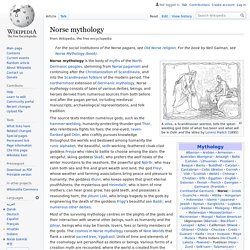
Ethnic minorities in the Nordic countries. 2019.02.07 | Thomas Hylland Eriksen Caption from The Foreign Workers' Journal (Fremmedarbejderbladet), a monthly newspaper aimed at foreign workers in Denmark in different languages from 1972.

Copyright: Adjs [CC BY-SA 4.0], Wikimedia. North Germanic peoples. North Germanic peoples, commonly called Scandinavians,[1] Nordic peoples[2] and in a medieval context Norsemen,[1] are a Germanic ethnolinguistic group of the Nordic countries.[3] They are identified by their cultural similarities, common ancestry and common use of the Proto-Norse language from around 200 AD, a language that around 800 AD became the Old Norse language, which in turn later became the North Germanic languages of today.
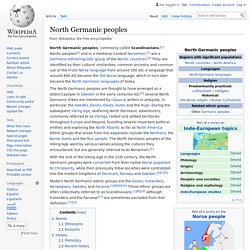
With the end of the Viking Age in the 11th century, the North Germanic peoples were converted from their native Norse paganism to Christianity, while their previously tribal societies were centralized into the modern kingdoms of Denmark, Norway and Sweden.[6][7][5] Modern North Germanic ethnic groups are the Danes, Icelanders, Norwegians, Swedes, and Faroese.[1][8][9][10] These ethnic groups are often collectively referred to as Scandinavians,[1][8][10] although Icelanders and the Faroese[11] are sometimes excluded from that definition.[12][3] Names[edit]
Gender Equality. The Norwegian strategy to achieve gender equality includes both gender mainstreaming and gender specific actions.

Photo: iStock by Getty Images. Gender equality is a fundamental human right and achieving equality between women and men is embedded in the UN Sustainable Development Goals (SDG). Norway is considered to be one of the most gender equal countries in the world. Still, a number of challenges to gender equality remain and new gender issues keep surfacing. Gender equality policies have been more or less successfully integrated into many areas, while other areas lag behind.
The Nine Realms in Norse Mythology. There are nine realms in Norse Mythology, they are called Niflheim, Muspelheim, Asgard, Midgard, Jotunheim, Vanaheim, Alfheim, Svartalfheim, Helheim.
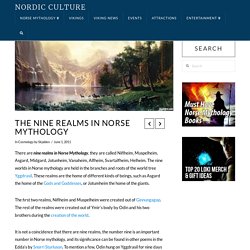
The nine worlds in Norse mythology are held in the branches and roots of the world tree Yggdrasil. These realms are the home of different kinds of beings, such as Asgard the home of the Gods and Goddesses, or Jotumheim the home of the giants. The first two realms, Niflheim and Muspelheim were created out of Ginnungagap. The rest of the realms were created out of Ymir’s body by Odin and his two brothers during the creation of the world. List of the Locations in Norse Mythology.
Alfheim: Alfheim is the home of the Elves.
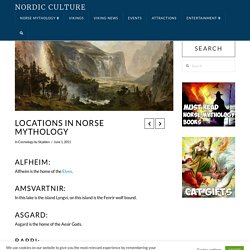
Amsvartnir: In this lake is the island Lyngvi, on this island is the Fenrir wolf bound. Asgard: Asgard is the home of the Aesir Gods. Gods and Creatures. The gods and other spiritual beings of Norse mythology are among the most wondrous and unique of any mythology.
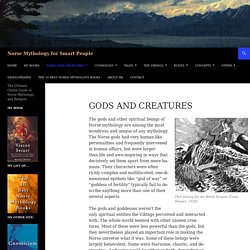
The Norse gods had very human-like personalities and frequently intervened in human affairs, but were larger-than-life and awe-inspiring in ways that decisively set them apart from mere humans. Their characters were often richly complex and multifaceted; one-dimensional epithets like “god of war” or “goddess of fertility” typically fail to describe anything more than one of their several aspects. The gods and goddesses weren’t the only spiritual entities the Vikings perceived and interacted with. The whole world teemed with other unseen creatures. Most of these were less powerful than the gods, but they nevertheless played an important role in making the Norse universe what it was. Creatures in Norse Mythology. From Odin’s mighty horse to a world-circling serpent, Norse Mythology has a cacophony of crazy creatures!
The world of fantasy is packed full of amazing mythical creatures such as Elves, Dwarfs and Giants. Everywhere, from Lord of the Rings to The Elder Scrolls games, these creatures are deeply woven into our cultural fabric. But what many people don’t realise is that most of these creatures take their cue directly from Norse mythology. Here, we take a look at the best of the best – from races such as elves to individual creatures such as the mighty Kraken – so for everything you need to know about the fantastic beasts, we’ve got you covered!
Elves. 15 Scariest Norse Mythology Creatures [Monster List] Some of the most interesting characters in Norse mythology are not the powerful gods.
![15 Scariest Norse Mythology Creatures [Monster List]](http://cdn.pearltrees.com/s/pic/th/scariest-mythology-creatures-242568996)
But rather the creatures that constantly appear to challenge the gods and terrorise men. Norse mythology – including the stories of Odin, Thor and Loki – was the basis of the religion of the Viking warriors that plundered Europe from the 8th to the 11th centuries. The religion went into decline around a thousand years ago when Christianity swept through the north of Europe. The Creation of the Cosmos. The Norse creation myth or cosmogony (an account of the origins of the cosmos) is perhaps one of the richest in all of world literature.
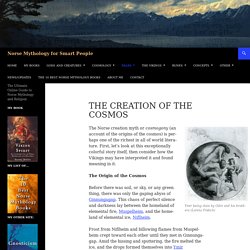
First, let’s look at this exceptionally colorful story itself, then consider how the Vikings may have interpreted it and found meaning in it. The Origin of the Cosmos. Ask and Embla. Ask and Embla are the first humans – male and female, respectively – to be created in Norse mythology. The story of how they were created, as it has come down to us in Old Norse literature, goes like this: Not too long after the world itself was created, Odin was walking along the coast of one of the new land masses.
With him were two other gods: in one version, these were his brothers Vili and Ve,[1] and in another version, they were the obscure figures Hoenir and Lodurr.[2] Tales. The body of stories that we today call “Norse mythology” formed one of the centerpieces of the pagan Norse religion. These are the tales that Viking poets recited in dimly lit halls to the captivated attendees of grand feasts, and which fathers and mothers told to their children around roaring hearth-fires on long winter nights. They are epic myths of war, magic, love, betrayal, triumph, and ruin.
Not only did they provide deep wells of religious meaning for the Vikings; they also speak to much that is timeless and universal in the human condition, and so continue to provide modern audiences from around the world with wonder, entertainment, and even spiritual nourishment for some. Æsir. Principal pantheon in Norse mythology Etymology[edit] The modern Swedish word for atmospheric thunder - åska - "the god's ride" - retains the name.
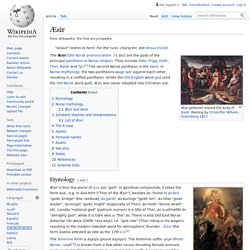
15 Major Norse Gods, Goddesses, And Their Family Tree. Of some of the renowned mythologies from history, the Norse gods and legends probably have one of the vaguest of origins, with their primary lore borrowed from a patchwork of oral traditions and local tales that were conceived in both pre-Christian ancient Germania and early medieval Scandinavia. Fortunately enough, as we discussed earlier (in one of the articles concerning various mythologies) – Many of these varied parcels of old fable were collected and compiled in manuscripts (comprising Old Norse texts), in circa 13th century Iceland. BBC - Religions - Paganism: History of modern Paganism.
Norse Mythology. Norse mythology is the body of mythology practised in Scandinavia (Norway, Sweden and Denmark) stemming from paganism and continuing after the introduction of Christianity. Norse mythology encompasses figures and stories from numerous sources, medieval manuscripts, archaeological evidence and folk tradition, from before and after the pagan era. Some of these deities include Thor, Odin, Freyja, Skaoi, Njoror and Loki.
This religion was animistic (the attribution of a soul to flora, fauna and inanimate objects), polytheistic (the worship of multiple Gods), pantheistic (the universe is a manifestation of the deities) and held a cyclical view of time. Hiking in Sweden. Best Skiing in Sweden. Outdoor Activities in the Nordic countries. Sweden: Exploring Swedish Culture. Nordic Model Definition. Scandinavian literature. Linguistics. Scandinavian literature. Nordic art. Sweden: population by level of education 2019. Education in Scandinavia - statistics & facts. 5 Favorite Scandinavian Foods. Fiddle. Dulcimer. Sweden: population 2020. Nordic folk music. Politics of Sweden. Definition, Beliefs, History, & Facts.
The Weather and Climate in Scandinavia. What is the main religion in Scandinavia? - Quora. Religion in Norway. The Weather and Climate in Scandinavia. The seasons of Scandinavia. Are Scandinavian languages mutually understandable? - Countries, Map, & Facts. Scandinavia.